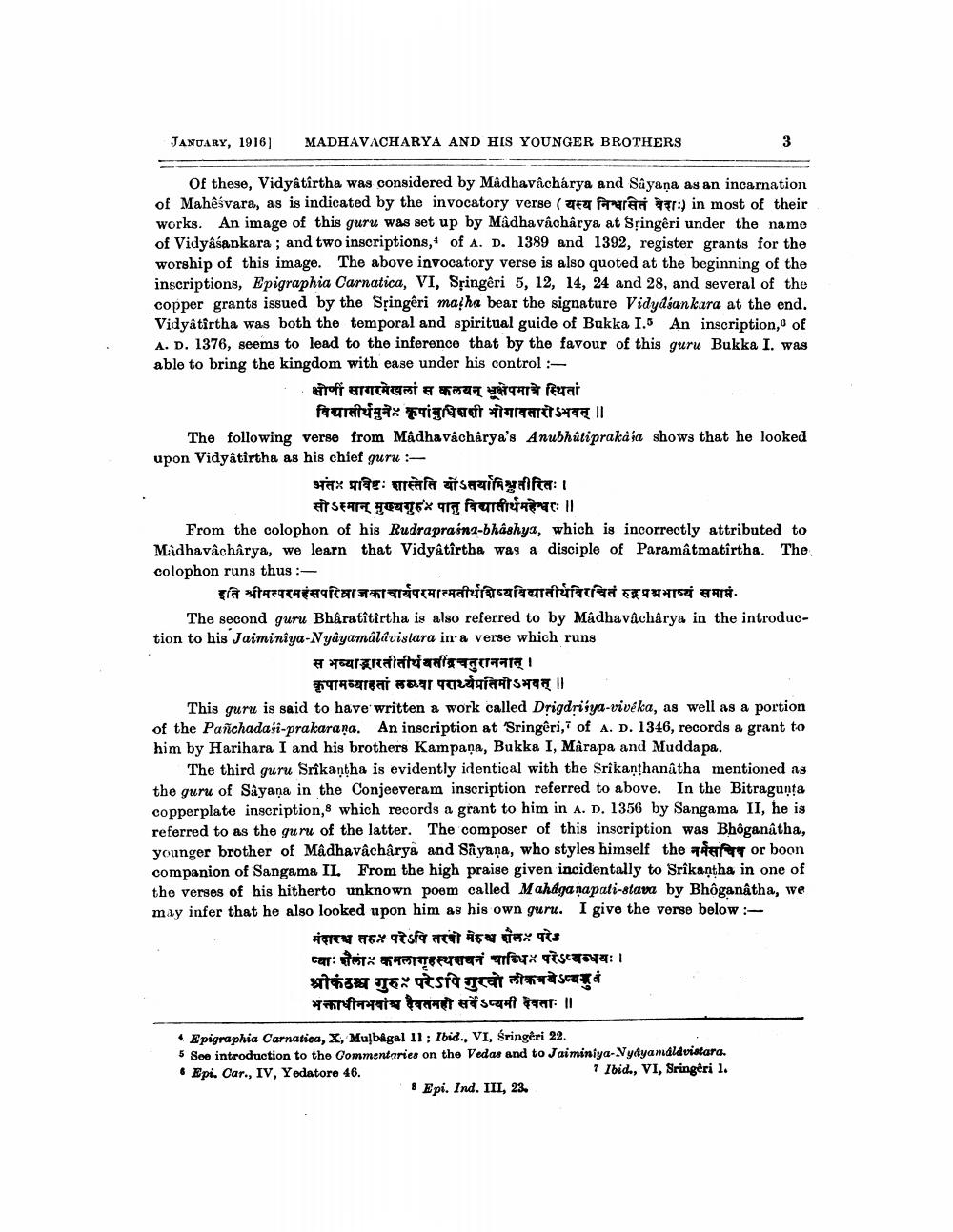Book Title: Indian Antiquary Vol 45 Author(s): Richard Carnac Temple, Devadatta Ramkrishna Bhandarkar Publisher: Swati Publications View full book textPage 7
________________ JANUARY, 1916) MADHAVACHARYA AND HIS YOUNGER BROTHERS Of these, Vidyâtîrtha was considered by Madhavacharya and Sayaņa as an incarnation of Maheśvara, as is indicated by the invocatory verse (Try farasi :) in most of their works. An image of this guru was set up by Madhavacharya at Sringeri under the name of Vidyasankara ; and two inscriptions, of A. D. 1389 and 1392, register grants for the worship of this image. The above invocatory verse is also quoted at the beginning of the inscriptions, Epigraphia Carnatica, VI, Sringeri 5, 12, 14, 24 and 28, and several of the copper grants issued by the Spingêri ma ha bear the signature Vidydsankara at the end. Vidyâtirtha was both the temporal and spiritual guide of Bukka 1.6 An inscription, of A. D. 1376, seems to lead to the inference that by the favour of this guru Bukka I. was able to bring the kingdom with ease under his control : क्षोणी सागरमेखलां स कलयन् भूक्षेपमात्रे स्थितां विचातीर्थमुने कृपांबुधिशशी भोगावतारोऽभवत् । The following verse from Madhavacharya's Anubhűtiprakasa shows that he looked upon Vidyatirtha as his chief guru : X E: grafa sifayalfta: 1 सोऽस्मान् मुख्यगुरु पातु विद्यातीर्थमहेन्धरः ॥ From the colophon of his Rudrapraśna-bhashya, which is incorrectly attributed to Midhavâchârya, we learn that Vidyatîrtha was a disciple of Paramâtmatîrtha. The colophon runs thus : इति श्रीमत्परमहंसपरिव्राजकाचार्यपरमात्मतीर्थशिष्यविद्यातीर्यविरचितं रुद्रप्रभभाष्यं समाप्त. The second guru Bharatîtîrtha is also referred to by Madhavacharya in the introduction to his Jaiminiya-Nyâyamálävistara in a verse which runs स भव्याट्रारतीतीर्थवींद्रचतुराननात् । कृपामव्याहतां लब्या परायेप्रतिमोऽभवत् ॥ This guru is said to have written a work called Drigdriya-viveka, as well as a portion of the Panchadasi-prakarana. An inscription at 'Sringeri, of A. D. 1346, records a grant to him by Harihara I and his brothers Kampaņa, Bukka I, Marapa and Muddapa. The third guru Srikantha is evidently identical with the Srikanthanatha mentioned as the guru of Sayaņa in the Conjeeveram inscription referred to above. In the Bitragunta copperplate inscription, which records a grant to him in A. D. 1356 by Sangama II, he is referred to as the guru of the latter. The composer of this inscription was Bhôganatha, younger brother of Madhavacharya and Sayana, who styles himself the art or boon companion of Sangama IL. From the high praise given incidentally to Srikantha in one of the verses of his hitherto unknown poem called Mahdganapati-stava by Bhôganatha, we may infer that he also looked upon him as his own guru. I give the verse below: मंदारच तरु४ परेऽपि तरषो मेहश्च शैल: परेड प्याःशैला कमलागृहस्थशवनं चाब्धि: परेऽम्बन्धयः । श्रीकंठश्व गुरु परेऽपि गुरवो लोकत्रयेऽन्यदुवं भक्ताधीनभवांव देवतमहो सर्वेऽप्यमी देवताः ॥ * Epigraphia Carnatioa, X, Mulbågal 11 ; Ibid., VI, Sringeri 22. 5 Soo introduction to the Commentaries on the Vedas and to Jaiminiya-Vydyamaldvistara. 6 Epi. Car., IV, Yedatore 46. 1 Ibid., VI, Sringeri 1. 8 Epi. Ind. III, 23.Page Navigation
1 ... 5 6 7 8 9 10 11 12 13 14 15 16 17 18 19 20 21 22 23 24 25 26 27 28 29 30 31 32 33 34 35 36 37 38 39 40 41 42 43 44 45 46 47 48 49 50 51 52 53 54 55 56 57 58 59 60 61 62 63 64 65 66 67 68 69 70 71 72 ... 380
